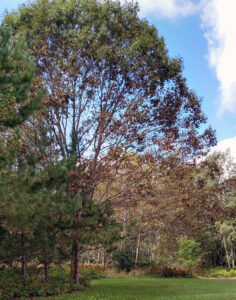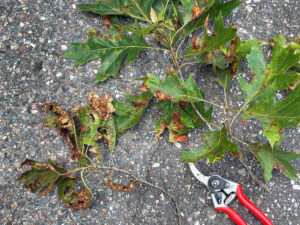By Linda Williams, DNR Forest Health Specialist, Woodruff;
Linda.Williams@wisconsin.gov or 920-360-0665

A tree showing that lower branches are thin and have lost leaves due to Tubakia leaf spot, while leaves on its upper branches look good. / Photo Credit: Linda Williams, Wisconsin DNR.
Tubakia leaf spot is a leaf disease caused by a fungus (Tubakia dryina) that typically affects the lower canopy of red oaks.
Because of all the rain that came during the spring and early summer of 2024, the fungus has started to impact some trees. Problems didn’t occur last year because the weather was too dry.
Symptoms usually start in the lower canopy because there is more moisture closer to the ground. Leaves may be shriveled, show brown blotches or even drop to the ground.
Branches at the top of the tree often still have green leaves, which can help distinguish Tubakia leaf spot from oak wilt, where leaves will drop from the top of the tree or outer parts of branches first.
This species of Tubakia fungus is different than the one that causes bur oak blight on bur oaks.

Leaves on the lower left are severely affected by Tubakia fungus, while leaves in the upper right are less affected with fewer brown blotches. / Photo Credit: Linda Williams, Wisconsin DNR.
Although initial infection by the fungus occurs early in the season, symptoms don’t develop until later. Tree growth is generally not affected, even for severely infected trees. In urban areas, removing infected leaves can help reduce future infections. In forested areas, lower branches may die but that doesn’t usually kill the tree, so management is not necessary.
